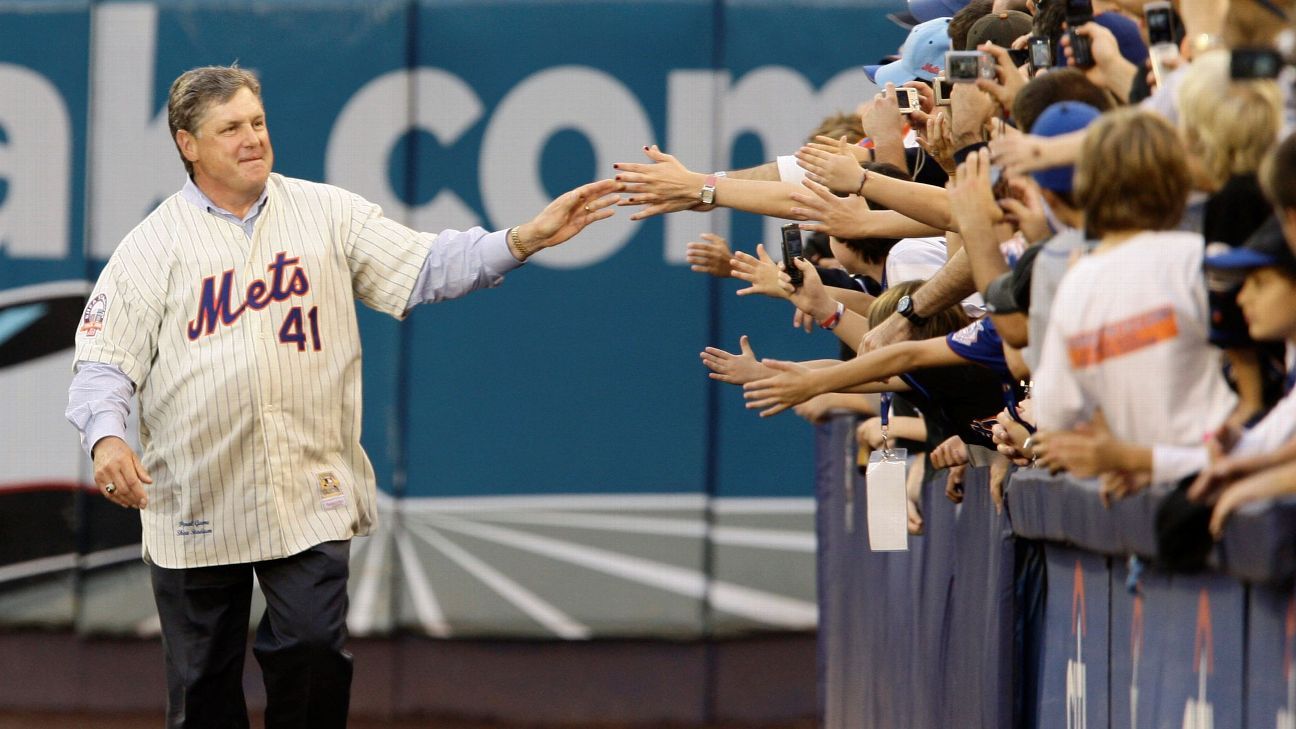By the time I was 5 I would come to understand that Superman, Batman and Spider-Man were not actually somewhere outside our apartment on West 10th Street.
That wasn’t true of Tom Seaver. He was the superhero we could go see in Queens.
The best pitcher in the game was on my team, had my name, wore the same cap I had. He would certainly understand why I took a black felt-tip pen and, with great deliberation, consecrated the back of my pinstriped Mets shirt with a ragged “41.”
I never forgave my parents for leaving New York City to move to Iowa (long story), but even in that foreign land, when I traced my finger over the raised orange stitches of the “NY” on my cap, the same as his cap, with “Tom Seaver” scrawled under the brim in black felt-tip pen, I knew he was out there. Until an 8-year-old learned about the oblivious cruelty of the adult world through a trade to the Reds. My parents had Walter O’Malley and I had M. Donald Grant.
Even while he was in Cincinnati, Tom Seaver was mine, and I knew that if he could leave, that meant he could come back. He did come back to the Mets in 1983, and then I learned the agony that comes with wanting something to be the way it was. Seaver was 9-14 that season. It wasn’t such a great year for my parents, either; they split up for good.
One of the first things I learned as a young baseball writer was that you’d better be prepared to hear some awful things about the men you admired as a boy. That knowing laugh you’d get from the older writers when you asked if this or that Hall of Famer was a “good guy.” Eventually you stop asking.
So when I was covering the Mets in 1999 and it was announced that Tom Seaver was returning to the club as an announcer and instructor, I had the scars of almost three decades to gird me for one more disappointment, what I knew would be the most painful of all.
Tom Terrific arrived in Port St. Lucie late, and he toured the camp in a chauffeured golf cart as though he were riding in a chariot. He reveled and waved the way Roman gods do and he was clearly pleased that he was Tom Seaver. At the end of the day, we newspaper writers waited in the dugout for our audience. He was late for that, too. I turned to Mike Vaccaro of the New York Post, who shared my age and Mets breeding, and I said, “I don’t care who he is, I’m going to rip him.” Vac nodded.
When Seaver did finally take his seat on the dugout bench, he apologized. He was engaging and charming, but I knew with the insight of a now-jaded 29-year-old sportswriter that this was just the act that legends trot out for those on the outside.
I wish I remembered what I said, but at one point I cracked a little joke and Tom Seaver broke up. Fully and loudly. I blushed. Vac leaned over and whispered, “That was awesome.” I whispered back, “I know.”
No other living person could have made me feel that way. Batman could not have made me feel that way. The 8-year-old who had cried over a baseball trade was still there and couldn’t wait to get to a phone to tell his parents, even if I had to make separate calls to do it.
Tom Seaver thought I was funny. Tom Seaver would come to know my name. Tom Seaver would take my calls in the offseason. He told me about something funny his wife, Nancy, had said, about how his grapes had come in that summer, about how my son had to learn to slap that front foot down if he wanted to throw a great slider.
Yes, Tom Seaver knew exactly how great he was, but he also knew his greatness was not his to keep to himself because it meant a considerable deal to people like me. He tended to his legend as he would his grapes, and I knew that he rode around the golf cart like Caesar because that’s who the citizens of the Mets empire needed him to be, the greatest player from their greatest team.
“Did I ever tell you about the dinner I organize at Cooperstown every year?” he said once. “It’s me, Sandy Koufax, Bob Gibson, Gaylord Perry and Warren Spahn. Sandy and Gibby are the only ones without 300 wins. You know what we call them?” He paused. “Our fourth and fifth starters.”
We roared together in laughter and I immediately started thinking of who I could tell.
He once told me at the end of a conversation that he always liked talking baseball with me because I knew the game. I don’t care if he meant it. Tom Seaver wanted me to feel like I belonged on the inside and god almighty was that good enough.
It has been a long time since I last spoke to him. It happens. Even with distance he was still mine, still ours. It was devastating to hear last year that he was retiring from public life because of his dementia, and that the former Marine with one of the sharpest minds in the game was fading badly.
And I’m reminded now that loving Tom Seaver always meant understanding that he might have to leave.
